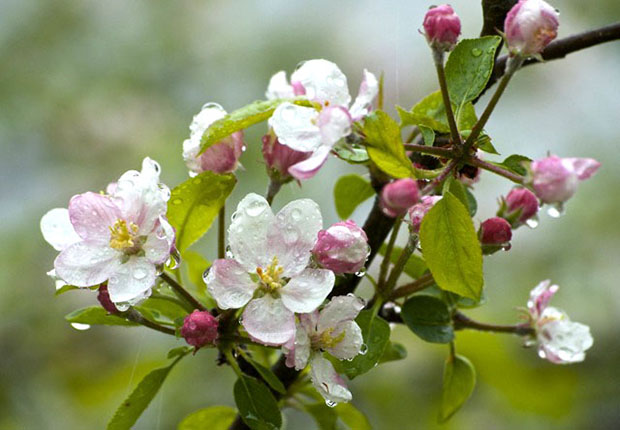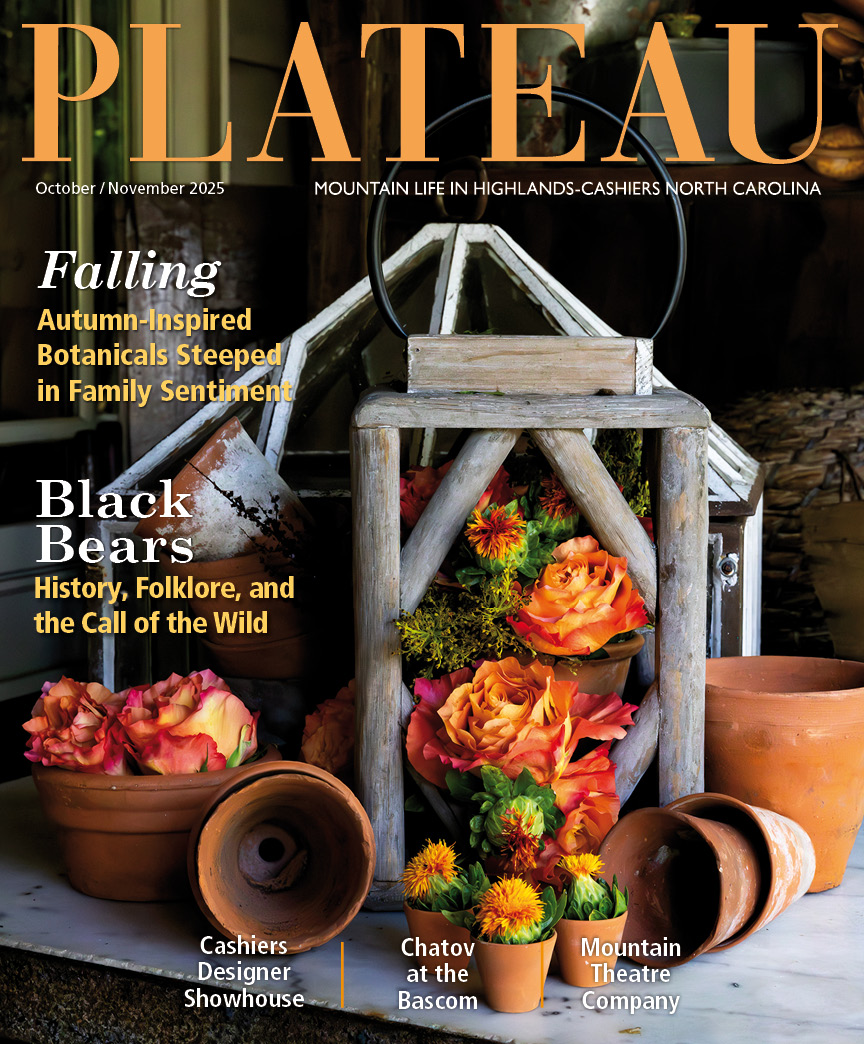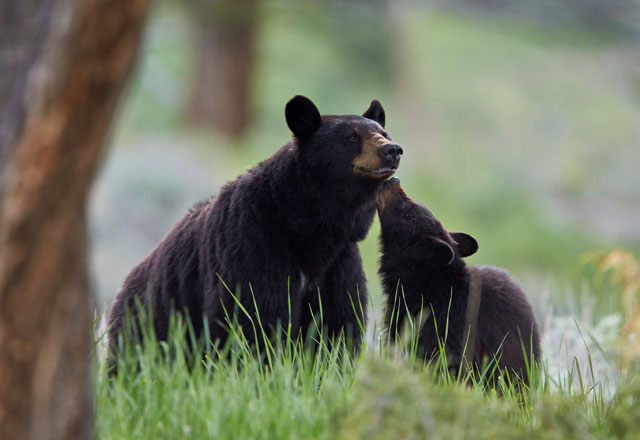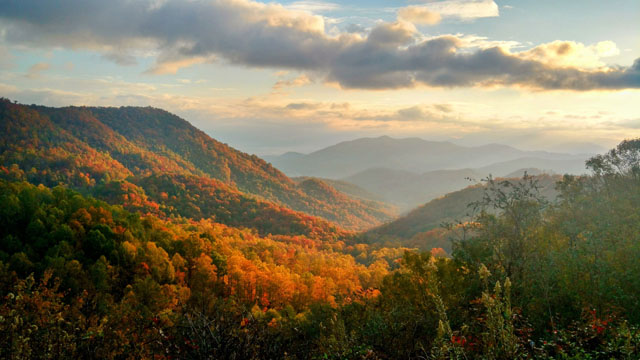Mountain Living 411
07 Feb 2022
A list of things you don’t want to learn the hard way
By Kat Ford
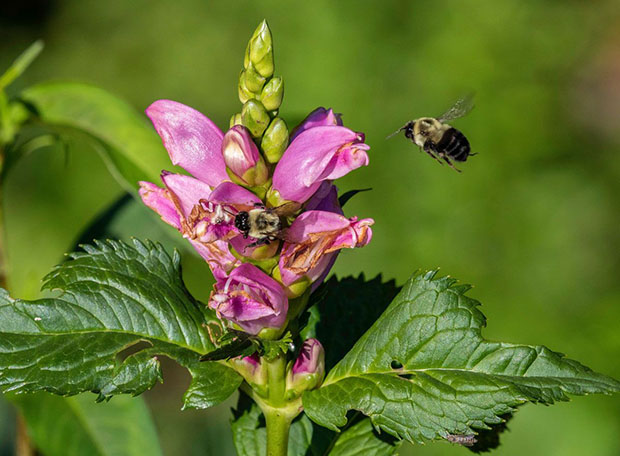
You’re sitting on the back porch of your new home or Airbnb rental, coffee in hand, gazing over the majestic mountains. Your phone is full of screenshots from hikes you want to explore, shops and restaurants you want to visit and selfies you want to recreate. You’ve been following Pinterest boards and Instagram accounts; you’ve read every travel blog on western North Carolina. You can’t believe you are finally here.
Welcome, new friends, to the plateau. I have no doubt that you will quickly immerse yourself in the beauty, camaraderie and natural, understated casual luxury that is our treasured corner of North Carolina. But there are a few other practices that might take a little longer to identify, the sort of customs you don’t recognize until you’ve spent significant time in an area. The type of wisdom you don’t truly understand until you are nearly run off the Gorge Road by an eighteen-wheeler or experience the shock of walking up to your car only to realize you are standing between a mother black bear and two cubs (both firsthand accounts from this writer and equally terrifying). When it comes to mountain living, you can rely on the three s’s: safety, sageness and stewardship.
Safety
Our windy roads make for great Sunday drives, especially during the change of seasons. However, one person’s leisurely cruise may be another’s white-knuckled “I’m certain I’m about to drive off this cliff” nightmare, another’s “Hurry up; I need to get to work” commute. According to the Glenville-Cashiers Rescue Squad (GCRS), the accidents they see are resultant from distracted, inattentive and aggressive driving in almost all cases. There is no shortage of natural impediments on our roads, including falling trees and branches, crossing wildlife (especially at twilight and night), fog, heavy rain, snow or ice to make even the most experienced driver flinch. Add the human element, ubiquitous sharp turns, steep climbs and blind spots, and you’ve got a motley crew of driving obstacles. It’s for these reasons that our slower mountain speed limits exist. For cruising or timid drivers, remember that there are plenty of pull-offs on the side of the road. These will allow you to take a breath or study the scenery while letting the cars behind you move along. Our winding roads and climate can be hard on an automobile, and a well-maintained, serviced vehicle is paramount. In our June/July 2021 issue, we discussed plateau car maintenance with Russell Marling at Highlands Automotive; you can read the archived article, “Your Daily Drive,” on www.theplateaumag.com.
For homeowners and visitors, it is eminent to identify a quick and reliable way to make a 911 emergency call and to ensure that emergency responders can find you at your location. That seems to go without saying, but according to GCRS, it’s a big issue. “With an old-fashioned telephone landline, the calling party’s physical address is hard-wired into the system and location information is delivered in real-time to the 911 call center and dispatcher. With more and more people moving to cell phones and Voice over Internet Protocol (VoIP) technology, this has become more problematic as real-time physical location data is not as readily available and communicated to responders,” says Nat Tuner of the GCRS. While cell phones are now increasingly equipped with GPS systems, this information may not be quickly translated into an accurate physical street address for 911 responders. Unless you’ve correctly registered your user account information with an up-to-date location, your 911 VoIP call could be sending emergency teams out of state or further. An additional issue with VoIP calls is their reliance on electricity and the internet. Recall the last time you tried to stream your favorite Netflix series during a storm. Now consider relying on that connectivity to save your life. The best way to reach 911 is from a landline which provides direct location information to responders. The takeaway lesson here is to make sure that any caller (including children, babysitters and guests) knows the physical address of where you are staying and that they must articulate that information when calling 911. “In an emergency, seconds truly matter and it’s imperative to make sure contact can be made with reliable location information,” says Turner.
When preparing for an emergency, the next step is guaranteeing first responders can find your house. Unmarked house numbers are such an issue for first responders that in December 2021, the Jackson County Emergency Management Facebook page shared a picture from a volunteer fire department in New York that read, “All we want for Christmas is your house numbers on your mailbox.” Of course, every homeowner values curb appeal, especially in an area as picturesque as our mountains. Still, in a situation where seconds count, a first responder must be able to identify your house or location. “Decorative street numbers are certainly acceptable, but please make sure they are readable for a responder arriving from any direction; we may be arriving at night or during a hard rainstorm. Simple and highly visible silver reflective signs and numbers are best,” says Turner.
An ability to pinpoint your location during an emergency is not solely for hours spent indoors. With hundreds and hundreds of miles of wilderness hiking trails in our area, and a comparable number of spectacular waterfalls and long-range vistas, there is no lack of available outdoor activities to pursue. Although these activities are generally very safe, the GCRS is called for approximately 30-35 Search & Rescue (SAR) operations each year. With more enthusiasts taking to the outdoors during the pandemic, these numbers have seen a steady rise. “The majority of these calls are for lost hikers or folks unable to make it back to the trailhead before the onset of darkness and a cold night,” says Turner. “Although accidents can occur on a seemingly random basis, safety often seems to favor the prepared. In reviewing the root causes of our SAR incidents, a lack of preparation is without a doubt the most common item.” It is for this reason that the GCRS created their PANNIC Free hiking tips.
Sageness
When I was a teenager, my father said the same thing to me every time I walked out the door, “keep your wits about you.” It seemed embarrassing at 16 but became invaluable soon after. My father was a man of preparedness, which was a helpful baseline when moving to the plateau. With weather that ranges from snow to tropical storms, vigilance is key. A well-stocked tool kit, axe, snow shovel, portable generator, potable water and dried food are always in my storm kit. There are several local retailers on the plateau who can assist in researching your generator needs based on your family or home. Remember that electricity also can affect Wi-Fi, heating, cooling and your water pump. Therefore, many advise to fill the bathtub with water before a storm. (Another firsthand account from this writer, it takes melting many spaghetti pots of snow on a woodburning stove in order to flush the toilet after three days of no electricity.) Even when clear skies return, it might take days to get electricity back if there is deep snow or area-wide tree damage to power lines. Any preparedness fan would swoon over our local outdoor and hardware stores, with inventory guaranteed to help you weather any summer or winter storm.
Hazardous weather isn’t the only part of our climate that requires a watchful eye. “Western North Carolina is in the Appalachian temperate rainforest. Temperate rainforests are forests in the mid-latitudes that are cool and wet due to marine influence and heavy rainfall. They have dense canopy cover and an understory of mosses and lichens. Along with consistently high dew points and warm temperatures on the plateau, these elements produce an environment that is very favorable for a wide variety of mold species,” says Jesse Jones, a professional, certified mold inspector and owner of Mold-X located in Cashiers, NC. Although molds commonly found in western North Carolina are essential to our ecosystem, it is not good to have mold inside a home with limited airflow. “In 2016, North Carolina healthcare costs associated with disorders from mold included 13 million dollars for bronchial, 32 million dollars for asthma and 81 million dollars for rhinitis-related issues,” says Jones.
“There are several signs that may cause a homeowner to suspect mold is present inside their home. One sign is visually seeing mold on walls, ceilings, furniture and other surfaces. Another sign that elevated levels of mold are inside a home is the smell. Elevated mold levels in a home will produce a strong, musty odor. A third sign is when a person has triggered mold allergies, such as allergic rhinitis and asthma, while inside the home. Some of the symptoms include watery eyes, itchy eyes, nose and throat, sneezing, runny or stuffy nose, coughing, wheezing or shortness of breath. If a homeowner is experiencing any of these signs of mold in their home, a professional, certified mold inspector should be contacted.”
Stewardship
When living and playing here, it is important to remember that we are stewards of this area, if only for a short period of time. Our local nonprofits are here to help us make informed decisions. Harry McDonald, the incoming board president for the Highlands Historical Society, encourages residents and guests to learn about the area through their museum, which is "a great place to visit that truly displays many aspects of Highlands history. Next to the museum is the Prince House, the oldest home in Highlands. Every time I go through the Prince House, I become aware there are no bathrooms, no running water and no central heat. I think it is important for our generation to get a feel for how Highlanders lived over 100 years ago and the contribution our previous generations made for the great life we enjoy in Highlands today." Similarly, The Cashiers Historical Society offers opportunities for learning on their grounds, including seven historical landmarks and trails. The Cashiers Historical Society also encourages adaptive reuse of historical Cashiers properties by bestowing their annual Village Heritage Award; businesses throughout the Cashiers crossroads proudly display this plaque.
Though stewardship is often linked to conservation, private property owners can do a great deal to ensure development on the plateau protects our ecosystem. In fact, the Highlands-Cashiers Land Trust (HCLT) notes that there is enough private, unconserved land in the area that were it all to be developed, we would see our sandy soils erode, habitat fragmentation, diseased flora and fauna, warmer unhealthy streams and rising water temperatures. HCLT lists conscientious topics for consideration, including underground electrical utilities to reduce the risk of fires, opting out of larger homes or ridge-positioned homes which affect panoramic views for the community and often lack good water or deep soils for water and septic, minimizing ecological impact by fitting your home to the site (not your site to the home) and clustering buildings to lessen infrastructure. "Land trusts are not anti-development, just anti-bad development. Our landscape can only support so much building before it impacts our desire to be here. If too many people come to our part of the mountains and don't learn to live with nature, there is a danger we could destroy the very reason we all came in the first place," says Gary Wein, HCLT executive director. In tandem with a need to preserve our delicate ecosystem come safety concerns. "Roads can be a source of landslides in the mountains of western North Carolina. We have very steep slopes, and this combined with high rainfall means disturbance to the landscape by a road, creating the initiation point for a landslide," says Wein. For more information about how to landscape your property to fight erosion, read our October/November 2021 article "Eluding Erosion" online.
HCLT also notes the importance of assessing private property sites for important natural and cultural heritage before development. This diminishes impact on wetlands, rare plants, streams, old-growth forests or viewsheds. Before you start landscaping your dream mountain home, consider native plants. "Invasive species, left unmanaged, have the potential to destroy our delicate ecosystem," says Wein. The staff at the Highlands Biological Foundation (HBF) agrees, native species are "often more resilient and require less attention than exotic plants because they're adapted for our conditions. Many so-called weeds are great for our native pollinators. Let them bloom and you'll have color and company in your garden all summer long! Exotic invasive plants to avoid in our region include English ivy, vinca, Asiatic jasmine, liriope, Japanese stiltgrass, miscanthus grass, Chinese wisteria, oriental bittersweet and euonymus. The work of your garden does not stop at summer's end. Pollinators utilize the landscape throughout the year by nestling under leaf litter, hibernating below ground and even utilizing the hollow plant stalks in your garden and our diverse forests during the colder months. Planting native species, reducing pesticide use and leaving plant matter in your garden during the fall and winter are just a few ways you can support these pollinators."
Our area boasts immense biological diversity; North Carolina is home to at least 64 species of salamanders. The southern Appalachian region's cool, wet climate provides an ideal environment for these nocturnal amphibians, as water is essential to their survival. They can be found in both aquatic and terrestrial habitats but should be handled with care as many breathe through their skin. Rock cairns might be on your Instagram selfie wish list, but they negatively affect animals that live in water. These simple stacks may create a sense of nature-loving artistry in a curated photo, but they disrupt water flow, damage habitat, cause erosion and can fall on our beloved local wildlife. "If you find a salamander in its natural habitat beneath a rock or log, be sure to replace the rock or log on the ground prior to placing the salamander back beside its home to avoid injuring it," says the staff at HBF. You might also find a snake in our rural mountains. There are two venomous species (timber rattlesnake and copperhead) and 12 non-venomous species in our region. "Usually, the snake is caught off guard as much as we are! The best plan is to leave it alone and give it plenty of space. In general, if left alone, snakes pose no threat to humans or pets. Most snake bites occur when people attempt to handle a snake," says HBF staff.
The Highlands-Cashiers Plateau supports such a significant diversity and abundance of birds that it is listed as an Important Bird Area by the National Audubon Society, serving as an important migratory route for many bird species, including birds of prey such as bald eagles, peregrine falcons and various hawk species. The staff at HBF reminds us to enjoy bird watching in a way that supports our local species, "birds can be seen year-round, and many enjoy using bird feeders. This practice can be tricky in areas where bears are prevalent, as these large mammals are opportunistic feeders and are often attracted to these birdseed buffets. By planting native plants which serve as natural food sources for birds, you provide seeds, nuts, fruits and nourish the native insects that most songbirds need to survive during their first few weeks of life. Native plants also allow birds to feed without congregating around a single food source, reducing the risk of disease transmission."
It takes a while to get acclimated to an area and can take even longer to research the overwhelming amount of interconnectedness from such a cornucopian region. Luckily, our bountiful resources extend well beyond our natural beauty, with local businesses, nonprofits and organizations that are ready to help you have a local mindset 24/7, even if you only visit our mountains on the weekends.Sidebar one
For windy mountain driving, the Glenville-Cashiers Rescue Squad reminds you to:
BE A HAWK
- Be vigilant: sharp and blind mountain turns, animals, other drivers and wilderness.
- Eyes on the road: avoid cell phone calls and texting, don’t retrieve dropped items.
- Avoid travel during inclement conditions. Travel only once roads have been cleared.
- Heed speed limits and posted warning signs.
- Always wear your seatbelt, drive sober and drug-free.
- When approaching another vehicle, turn off high beams.
- Keep a minimum three-second cushion between you and the car in front of you, six seconds in bad weather.
The Glenville-Cashiers Rescue Squad encourages you to be PANNIC Free when hiking!
Preparation » The most frequent reason for a wilderness emergency call is lack of preparation. Check the weather. Study your map for expected trail conditions and hike time. Plan to stay out longer than expected and let someone know your route and time of return.
Appropriate Clothing » Conditions change quickly in the mountains, anticipate the unexpected. Dress in layers, using a water-wicking layer as a base. Wear headcover. Pack rain gear. Wear high traction boots, supportive shoes and quality socks. For remote hikes, take extra clothing- especially another pair of socks.
Navigation » Make sure you have a topographic map, compass, trail guide and/or GPS device.
Nutrition » Take plenty of water, a rule of thumb is one liter for every two hours. For long excursions bring a water purifying method. Pack food and snacks that do not require cooking.
Illumination » It is imperative to find your way along a trail in the dark. Don’t count on a cell phone. Pack a LED-type headlamp with a small pocket light as backup. Check the batteries.
Communication » Bring a fully charged cell phone and anticipate poor coverage. Use a Personal Locator Beacon (PLB). These can be lifesaving and send an SOS via satellite to first responders. Communicate your plans to others before you leave.
First Aid » Pack a small kit including bandaging, tape, band-aids, blister treatments, etc. Consider a First Aid class.
And a word of warning: Please do not venture from established trails and be aware of marked and posted danger and warning signs.
Did you know Highlands is a BearWise town? The Highlands Biological Foundation reminds you to be BearWise by:
- NEVER FEED OR APPROACH BEARS Feeding bears (intentionally or unintentionally) trains them to approach homes and people for more food. Bears will defend themselves if a person gets too close, so don’t risk your safety and theirs!
- SECURE FOOD, GARBAGE AND RECYCLING Food and food odors attract bears so don’t reward them with easily available food or garbage.
- REMOVE BIRD FEEDERS WHEN BEARS ARE ACTIVE Birdseed and other grains have a high calorie content making them very attractive to bears. The best way to avoid conflicts with bears is to remove feeders.
- NEVER LEAVE PET FOOD OUT Feed outdoor pets portion sizes that will be completely eaten during each meal and remove leftover food and food bowl. Securely store these foods so nothing is available to bears.
- CLEAN AND STORE GRILLS After you use an outdoor grill, clean it thoroughly and make sure that all grease and fat is removed. Store cleaned grills and smokers in a secure area that keeps bears out.
- LET NEIGHBORS KNOW Share news with your friends and neighbors about recent bear activity and how to avoid bear conflicts. Bears have adapted to living near people; are you willing to adapt to living near bears?
Hiking/Homeowner Tip: If you see a bear, try to stay calm. Bears are usually wary of people unless humans feed or provoke them. Never feed, approach, surround or corner the bear. If it changes its natural behavior because of your presence, you are too close. Back away slowly and once you are a safe distance away from the bear, make lots of noise to frighten the bear away.
Bees: Our native bees (including various species of carpenter bees, bumblebees, sweat bees, etc.) tend to be solitary and do not live in hives. Research has shown significant declines in native pollinator population sizes and ranges globally. In fact, up to 40% of pollinator species on Earth may be at risk of extinction in the coming years due to habitat loss, pesticide use and climate change. Highlands is a Bee City USA affiliate, providing a framework to conserve native pollinators by providing them with a healthy habitat that is rich in a variety of native plants that provide nest sites and is protected from pesticides. (HBF
Bats: Bats are vital in controlling insect populations and can consume nearly their body weight in insects each night! North Carolina has 17 different species of bats making it the most bat species-rich state on the East Coast. The plateau is a biological hotspot for bats with 13 bat species. They can become a nuisance and get into homes if there are damaged areas or openings they can get into. Use appropriate hardware/materials to prevent access through chimneys, vents, or other structures. Never touch or try to pick up a bat. If you have a bat in your home, contact a professional for assistance. (HBF)
Snakes: Snakes are often seen as scary creatures or thought of as the bad guys, however, they play an important role in ecosystems. Snakes keep populations of rodents, slugs and insects in check, and they serve as a food resource to other animals such as foxes, raccoons, bears, owls and more. (HBF)


